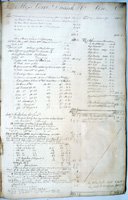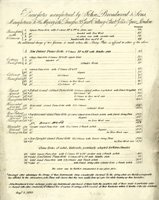
The two main series of records are the number books and porters' or day books. The number books act as an index to the porters' books. They contain the serial numbers of nearly all pianos made by John Broadwood & Sons from 1817 to 1952, arranged by type of piano (for example Grand, Cabinet, Square, Cottage, Upright). The same serial numbers were used for different types of instrument, so when researching a piano the type of piano and some indication of the approximate date of manufacture - often indicated by the instrument's aesthetic style or range - is required.

When the piano is sent away, the porters' book entry usually gives a customer name and shipping address, a brief description of the piano and any special features, the method of transportation (for example name of railway company or ship), the name of any agent, and the Broadwood porter responsible for its transport, as well as the cost of the piano and transport fees.
Any later entries for the same piano are often related to repair or refinement of the piano, or its removal to another location or for storage. In the case of 'artistic' pianos, some were occasionally called back to be included in exhibitions, in which case this fact will be mentioned. Some pianos were hired out, including for concert use, and these details are also recorded, as for example when Chopin played in London in 1848.
From the 1820s prices begin to be noted in the porters' books. Prices are sometimes quoted in a code based on the word Cumberland, denoting the figures from 1 to 9, with D being 0, (for example, £ND with E% commission denotes £90 with 5% commission).
Many sales recorded in the porters' books are straightforward with the name recorded being the actual customer. However, there are often exceptions: some pianos are sold to dealers or music warehouses or exported to foreign agents, and the records do not tell us who the final customer was.

Some typical entries from an early porters' book include:
'21 December 1802, A G.P.F. [grand pianoforte] no.2320 and cover and case addressed Mr Richard Boyton, music warehouse, Bristol, delivered at Gerrards Hall, Basing Lane, goes by Fromonts waggon';
22 December 1802 'Taking S.P.F. [square pianoforte] Ornd [ornamented] D.P. no.6809 on hire to Lady Catherine Graham's, no.91 Jermyn Street'.
The other main series of records are the customer ledgers, 1794 to 1972, with separate series for wholesale and retail customers. The sales ledgers include details of all transactions including hire, carriage and sales of pianos and furniture and accessories (for example piano stools, covers, candle sconces, wire). Details of all tuning contracts were entered in the sales ledgers until circa 1900, after which date they were entered in separate tuning books. There are indexes to the ledgers, which allow searches for individual customer names to be made. However many of the ledgers, especially the indexes, also suffered damp damage in the past and some are not unfortunately available for consultation.
Further records that are valuable for researching individual pianos include printed price lists. A fine series of these survives from 1815 to 1972, showing the full range of what Broadwood made. The archive also contains black and white photographs of some instruments, chiefly late 19th century 'artistic' pianos.
See also
- John Broadwood and Sons Piano Manufacturers
- Broadwood customers and destinations
- Broadwood conservation project
- Beethoven Broadwood Piano Bicentenary, 1818 to 2018
Images
- Entry in Broadwood porters' book showing use of piano by Chopin, 1848 (reference 2185/JB/42/42)
- Entry in Broadwood customer ledger, 1795 to 1796 (reference 2185/JB/29/1/1)
- Price list for pianos, 1829 (reference 2185/JB/76/9)
The archives of Erard and Pleyel, the great French piano makers, whose history is more or less exactly contemporary with Broadwoods, are available online.

